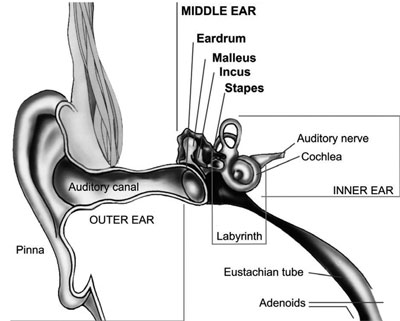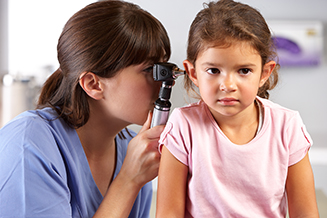How Do You Know if Your Infant Has an Ear Infection
What is an ear infection?
An ear infection is an inflammation of the centre ear, usually acquired by bacteria, that occurs when fluid builds upwardly behind the eardrum. Anyone tin get an ear infection, but children go them more than often than adults. 5 out of six children will have at least one ear infection past their tertiary birthday. In fact, ear infections are the virtually common reason parents bring their child to a physician. The scientific name for an ear infection is otitis media (OM).
What are the symptoms of an ear infection?
There are three master types of ear infections. Each has a different combination of symptoms.
- Acute otitis media (AOM) is the most common ear infection. Parts of the middle ear are infected and swollen and fluid is trapped behind the eardrum. This causes pain in the ear—commonly called an earache. Your child might also have a fever.
- Otitis media with effusion (OME) sometimes happens after an ear infection has run its course and fluid stays trapped backside the eardrum. A child with OME may have no symptoms, but a doctor will exist able to come across the fluid behind the eardrum with a special instrument.
- Chronic otitis media with effusion (COME) happens when fluid remains in the centre ear for a long time or returns over and over again, fifty-fifty though at that place is no infection. COME makes it harder for children to fight new infections and also can affect their hearing.
How can I tell if my child has an ear infection?
Near ear infections happen to children before they've learned how to talk. If your child isn't onetime enough to say "My ear hurts," here are a few things to look for:
- Tugging or pulling at the ear(southward)
- Fussiness and crying
- Trouble sleeping
- Fever (especially in infants and younger children)
- Fluid draining from the ear
- Clumsiness or bug with residuum
- Trouble hearing or responding to tranquility sounds
What causes an ear infection?
An ear infection commonly is caused by bacteria and ofttimes begins afterwards a child has a sore pharynx, cold, or other upper respiratory infection. If the upper respiratory infection is bacterial, these same bacteria may spread to the middle ear; if the upper respiratory infection is caused past a virus, such every bit a cold, bacteria may be drawn to the microbe-friendly environment and motion into the heart ear as a secondary infection. Considering of the infection, fluid builds up behind the eardrum.
Parts of the ear

The ear has three major parts: the outer ear, the center ear, and the inner ear. The outer ear, also called the pinna, includes everything we see on the outside—the curved flap of the ear leading down to the earlobe—just it also includes the ear culvert, which begins at the opening to the ear and extends to the eardrum. The eardrum is a membrane that separates the outer ear from the heart ear.
The heart ear—which is where ear infections occur—is located between the eardrum and the inner ear. Within the center ear are three tiny bones called the malleus, incus, and stapes that transmit sound vibrations from the eardrum to the inner ear. The bones of the middle ear are surrounded by air.
The inner ear contains the labyrinth, which help us keep our residuum. The cochlea, a function of the labyrinth, is a snail-shaped organ that converts sound vibrations from the heart ear into electrical signals. The auditory nervus carries these signals from the cochlea to the brain.
Other nearby parts of the ear also tin be involved in ear infections. The eustachian tube is a small passageway that connects the upper part of the throat to the middle ear. Its chore is to supply fresh air to the centre ear, drain fluid, and go along air force per unit area at a steady level betwixt the nose and the ear.
Adenoids are small pads of tissue located behind the back of the nose, above the throat, and most the eustachian tubes. Adenoids are generally made upward of immune organization cells. They fight off infection past trapping bacteria that enter through the oral fissure.
Why are children more than likely than adults to go ear infections?
There are several reasons why children are more likely than adults to get ear infections.
Eustachian tubes are smaller and more level in children than they are in adults. This makes information technology hard for fluid to drain out of the ear, even under normal conditions. If the eustachian tubes are swollen or blocked with mucus due to a cold or other respiratory affliction, fluid may not be able to drain.
A child's allowed system isn't every bit effective as an adult's because it's still developing. This makes it harder for children to fight infections.
As office of the immune organisation, the adenoids respond to bacteria passing through the nose and oral cavity. Sometimes bacteria get trapped in the adenoids, causing a chronic infection that can so pass on to the eustachian tubes and the middle ear.
How does a physician diagnose a middle ear infection?
The commencement affair a doctor volition do is ask you well-nigh your child'due south wellness. Has your child had a caput cold or sore throat recently? Is he having trouble sleeping? Is she pulling at her ears? If an ear infection seems likely, the simplest way for a dr. to tell is to use a lighted instrument, chosen an otoscope, to look at the eardrum. A reddish, bulging eardrum indicates an infection.
A doctor also may use a pneumatic otoscope, which blows a puff of air into the ear canal, to check for fluid behind the eardrum. A normal eardrum will move back and forth more easily than an eardrum with fluid behind it.
Tympanometry, which uses sound tones and air pressure, is a diagnostic test a dr. might utilise if the diagnosis still isn't clear. A tympanometer is a small, soft plug that contains a tiny microphone and speaker as well every bit a device that varies air pressure in the ear. Information technology measures how flexible the eardrum is at unlike pressures.
How is an acute heart ear infection treated?
Many doctors will prescribe an antibiotic, such every bit amoxicillin, to be taken over seven to 10 days. Your doctor also may recommend over-the-counter pain relievers such equally acetaminophen or ibuprofen, or eardrops, to aid with fever and hurting. (Considering aspirin is considered a major preventable risk factor for Reye'south syndrome, a child who has a fever or other flu-like symptoms should not be given aspirin unless instructed to by your doc.)

If your md isn't able to make a definite diagnosis of OM and your child doesn't have severe ear pain or a fever, your physician might ask you lot to look a 24-hour interval or two to encounter if the earache goes away. The American University of Pediatrics issued guidelines in 2013 that encourage doctors to observe and closely follow these children with ear infections that can't be definitively diagnosed, peculiarly those between the ages of 6 months to 2 years. If there'due south no comeback inside 48 to 72 hours from when symptoms began, the guidelines recommend doctors beginning antibody therapy. Sometimes ear hurting isn't acquired by infection, and some ear infections may get ameliorate without antibiotics. Using antibiotics cautiously and with good reason helps prevent the evolution of bacteria that become resistant to antibiotics.
If your medico prescribes an antibiotic, it's important to make sure your kid takes it exactly as prescribed and for the total amount of fourth dimension. Even though your child may seem better in a few days, the infection still hasn't completely cleared from the ear. Stopping the medicine also shortly could allow the infection to come back. It'southward also important to return for your child's follow-up visit, so that the physician tin can check if the infection is gone.
How long will information technology have my child to get ameliorate?
Your kid should start feeling improve within a few days later on visiting the doctor. If information technology'southward been several days and your child withal seems sick, call your physician. Your child might need a different antibiotic. Once the infection clears, fluid may still remain in the middle ear but unremarkably disappears within three to 6 weeks.
What happens if my child keeps getting ear infections?
To keep a centre ear infection from coming back, information technology helps to limit some of the factors that might put your child at risk, such every bit non being around people who smoke and not going to bed with a bottle. In spite of these precautions, some children may continue to take middle ear infections, sometimes every bit many every bit five or half dozen a year. Your doctor may want to expect for several months to see if things go better on their own simply, if the infections keep coming back and antibiotics aren't helping, many doctors will recommend a surgical procedure that places a modest ventilation tube in the eardrum to improve air flow and prevent fluid backup in the centre ear. The most commonly used tubes stay in place for six to ix months and require follow-upward visits until they fall out.
If placement of the tubes yet doesn't prevent infections, a doc may consider removing the adenoids to foreclose infection from spreading to the eustachian tubes.
Tin ear infections exist prevented?
Currently, the best way to prevent ear infections is to reduce the risk factors associated with them. Here are some things you might want to do to lower your child'due south risk for ear infections.
- Vaccinate your child against the flu. Make sure your child gets the influenza, or influenza, vaccine every year.
- Information technology is recommended that you vaccinate your child with the thirteen-valent pneumococcal conjugate vaccine (PCV13). The PCV13 protects against more types of infection-causing bacteria than the previous vaccine, the PCV7. If your child already has begun PCV7 vaccination, consult your doc most how to transition to PCV13. The Centers for Illness Control and Prevention (CDC) recommends that children nether age 2 be vaccinated, starting at 2 months of age. Studies take shown that vaccinated children get far fewer ear infections than children who aren't vaccinated. The vaccine is strongly recommended for children in daycare.
- Wash hands oft. Washing easily prevents the spread of germs and tin can help go along your child from catching a cold or the flu.
- Avoid exposing your baby to cigarette fume. Studies have shown that babies who are around smokers have more ear infections.
- Never put your baby down for a nap, or for the night, with a canteen.
- Don't allow sick children to spend time together. As much as possible, limit your child'southward exposure to other children when your child or your kid'southward playmates are sick.
What enquiry is beingness done on eye ear infections?

Researchers sponsored by the National Plant on Deafness and Other Communication Disorders (NIDCD) are exploring many areas to improve the prevention, diagnosis, and treatment of middle ear infections. For example, finding better ways to predict which children are at college risk of developing an ear infection could lead to successful prevention tactics.
Another area that needs exploration is why some children have more ear infections than others. For case, Native American and Hispanic children have more infections than do children in other ethnic groups. What kinds of preventive measures could be taken to lower the risks?
Doctors also are start to acquire more almost what happens in the ears of children who have recurring ear infections. They have identified colonies of antibody-resistant bacteria, called biofilms, that are present in the middle ears of well-nigh children with chronic ear infections. Agreement how to attack and kill these biofilms would be one fashion to successfully care for chronic ear infections and avoid surgery.
Understanding the impact that ear infections have on a child's spoken language and language development is another of import area of study. Creating more accurate methods to diagnose middle ear infections would assistance doctors prescribe more targeted treatments. Researchers also are evaluating drugs currently existence used to treat ear infections, and developing new, more than constructive and easier ways to administrate medicines.
NIDCD-supported investigators proceed to explore vaccines against some of the almost common bacteria and viruses that cause middle ear infections, such every bit nontypeable Haemophilus influenzae (NTHi) and Moraxella catarrhalis. 1 squad is conducting studies on a method for delivering a possible vaccine without a needle.
Where can I notice additional data well-nigh ear infections?
The NIDCD maintains a directory of organizations that provide information on the normal and disordered processes of hearing, balance, smell, taste, voice, speech, and language.
Use the following keywords to assist you search for organizations that can answer questions and provide printed or electronic information on ear infections:
- Otitis media (ear infection)
- Speech-language development
- Early on identification of hearing loss in children
NIDCD Information Clearinghouse
one Advice Avenue
Bethesda, Doctor 20892-3456
Toll-gratis voice: (800) 241-1044
Toll-gratuitous TTY: (800) 241-1055
Email: nidcdinfo@nidcd.nih.gov
NIH Publication No. 10–4799
March 2013
Source: https://www.nidcd.nih.gov/health/ear-infections-children
0 Response to "How Do You Know if Your Infant Has an Ear Infection"
Post a Comment